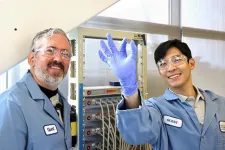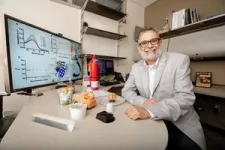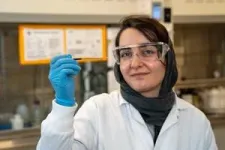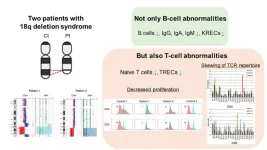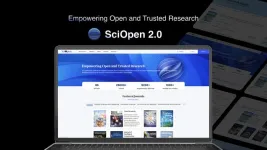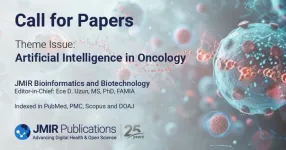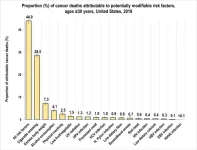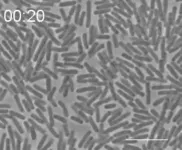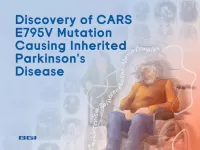Biological science helps fuel the future of electric air travel
A new study reveals a four-fold increase in cycle life for electric aircraft batteries thanks to a novel electrolyte solution discovered using a bioscience technique
2024-07-11
(Press-News.org)
– By William Ferguson
When it comes to figuring out why electric aircraft batteries lose power over time, one typically wouldn’t think to turn to a decades-old approach biologists use to study the structure and function of components in living organisms. However, it turns out that omics, a field that helped scientists unravel the secrets of the human genome, could also soon play a key role in making carbon-free air travel a reality.
In a new study in the journal Joule, a team of researchers led by the Department of Energy's Lawrence Berkeley National Laboratory (Berkeley Lab) used omics techniques to study the intricate interactions within the anode, cathode, and electrolyte of electric aircraft batteries. One of the most significant findings was the discovery that certain salts mixed into the battery electrolyte formed a protective coating on cathode particles, making them far more resistant to corrosion, thereby enhancing battery life.
The research team, which includes scientists from the University of California, Berkeley, University of Michigan, and industry partners ABA (Palo Alto, CA) and 24M (Cambridge, MA), then designed and tested an electric aircraft battery using their new electrolyte solution. The battery showed a four-fold increase when compared to conventional batteries in the number of cycles over which it could maintain the power-to-energy ratio needed for electric airflight. The next step in the project will be for the team to make enough batteries (approximately 100 kWh total capacity) for a projected 2025 test flight.
"Heavy transport sectors, including aviation, have been underexplored in terms of electrification," said Brett Helms, corresponding author of the study and a senior staff scientist at Berkeley Lab’s Molecular Foundry. “Our work redefines what's possible, pushing the boundaries of battery technology to enable deeper decarbonization."
Electric air travel presents unique challenges
Unlike electric vehicle batteries, which prioritize sustained energy over long distances, electric aircraft batteries face the unique challenge of high power needs for takeoff and landing, combined with high energy density for extended flight.
"In an electric vehicle, you focus on capacity fade over time,” said Youngmin Ko, a postdoctoral researcher at Berkeley Lab’s Molecular Foundry and lead author of the study. “But for aircraft, it's the power fade that's critical – the ability to consistently achieve high power for takeoff and landing."
According to Ko, traditional battery designs fall short in this regard, mostly due to a lack of understanding of what’s going on at the interfaces between the electrolyte, anodes and cathodes. Ko said this is where the omics approach came into play, a methodology borrowed from biological sciences to decipher patterns from changes in chemical signatures in complex systems.
“Biologists use omics to study the complex relationship between things like gene expression and DNA structure,” Helms said. “So, we wanted to see if we could use a similar approach to examine the chemical signatures of the battery's components and identify the reactions contributing to power fade and where they were occurring.”
The researchers focused their analysis on lithium metal batteries with high-voltage, high-density layered oxides containing nickel, manganese, and cobalt. Contrary to prior research, which has typically thought the power fade problem was a result of something happening in the battery’s anode, the team observed that power fade primarily stems from the cathode side. This was where particles cracked and corroded over time, hindering charge movement and reducing battery efficiency. In addition, the researchers found that specific electrolytes could control the corrosion rate at the cathode interface.
"It was a non-obvious outcome," Ko said. "We found that mixing salts in the electrolyte could suppress the reactivity of typically reactive species, which formed a stabilizing, corrosion-resistant coating."
After developing their new electrolyte, the researchers tested it in a high-capacity battery. It showed excellent power retention using a realistic mission for electric vertical take-off and landing. The team hopes to have the batteries produced for the projected 2025 flight test in an aircraft prototype made by four eVTOL (vertical takeoff and landing) partners by the end of the year. Looking ahead, Helms and Ko said the team and their collaborators plan to expand the use of omics in battery research, exploring the interactions of various electrolyte components to further understand and tailor the performance of batteries for current and emerging use-cases in transportation and the grid.
The Molecular Foundry is a DOE Office of Science user facility at Berkeley Lab.
This work was supported by DOE’s Advanced Research Projects Agency-Energy (ARPA-E) and DOE’s Office of Science.
###
Lawrence Berkeley National Laboratory (Berkeley Lab) is committed to delivering solutions for humankind through research in clean energy, a healthy planet, and discovery science. Founded in 1931 on the belief that the biggest problems are best addressed by teams, Berkeley Lab and its scientists have been recognized with 16 Nobel Prizes. Researchers from around the world rely on the Lab’s world-class scientific facilities for their own pioneering research. Berkeley Lab is a multiprogram national laboratory managed by the University of California for the U.S. Department of Energy’s Office of Science.
DOE’s Office of Science is the single largest supporter of basic research in the physical sciences in the United States, and is working to address some of the most pressing challenges of our time. For more information, please visit energy.gov/science.
END
ELSE PRESS RELEASES FROM THIS DATE:
2024-07-11
Images
A battery component innovation could help keep power delivery high when electric aircraft land with low charge, according to a study led by Lawrence Berkeley National Laboratory with expertise from the University of Michigan.
The research provides a solution to a problem identified in 2018 in a study led by Venkat Viswanathan, a professor of aerospace engineering at U-M and a coauthor of the new work published in Joule.
"Both takeoff and landing require high power, and landing is more challenging because you’re not fully charged," Viswanathan said. "To get high power you ...
2024-07-11
Tokyo Medical and Dental University (TMDU) researchers have discovered that patients with 18q deletion syndrome can experience both cellular and humoral immunodeficiency
Tokyo, Japan – Chromosome 18q deletion (18q del) syndromeis a rare genetic condition disorder, affecting approximately 1 in 40,000 to 55,000 individuals, caused by the deletion of genetic material on the long arm of chromosome 18. This genetic anomaly disrupts normal growth and development, and critically, can impair the immune system's functionality. Patients with 18q del syndrome often exhibit humoral immunodeficiency or a common ...
2024-07-11
On June 30, 2024, SciOpen 2.0 was officially launched. Developed by Tsinghua University Press, SciOpen initially made its debut in June 2022 as an international digital publishing platform for STM journals. After two years of global operation and continuous iterative upgrades, SciOpen 2.0 has fully embraced the best practices of mainstream publishing models. SciOpen has completed a comprehensive upgrade of its interactive system design and has integrated advanced large-model AI reading capabilities, marking a significant leap forward in its functionality.
These updates steer SciOpen towards ...
2024-07-11
(Toronto, July 11, 2024) JMIR Publications invites submissions to a new theme issue titled “Artificial Intelligence in Oncology” in its premier open access journal JMIR Bioinformatics and Biotechnology indexed in PubMed Central and PubMed, SCOPUS, Sherpa/Romeo, DOAJ and EBSCO/EBSCO Essentials.
Artificial intelligence (AI) has the potential to revolutionize oncology by enhancing diagnostic accuracy, personalizing treatment plans, predicting patient outcomes, and accelerating drug discovery. Researchers, clinicians, and industry experts are invited ...
2024-07-11
A new study led by researchers at the American Cancer Society (ACS) finds four in 10 cancer cases and about one-half of all cancer deaths in adults 30 years old and older in the United States (or 713,340 cancer cases and 262,120 cancer deaths in 2019) could be attributed to modifiable risk factors, including cigarette smoking, excess body weight, alcohol consumption, physical inactivity, diet, and infections. Cigarette smoking was by far the leading risk factor, contributing to nearly 20% of all cancer cases and 30% of all cancer deaths. The findings are ...
2024-07-11
The study by researchers from the French national public health institute aimed to identify priority pathogens that could be suitable for wastewater surveillance (WWS) during the Paris 2024 Olympic and Paralympic Games taking place from 26 July to 11 August and 28 August to 8 September, respectively. The pathogens were evaluated using a Delphi method which integrated evidence from peer-reviewed publications and expert opinion.
WWS has become more prominent due to its role during the COVID-19 pandemic. As a non-intrusive, cost-effective surveillance tool, WWS offers ...
2024-07-11
Dense E.coli bacteria have several similar qualities to colloidal glass, according to new research at the University of Tokyo. Colloids are substances made up of small particles suspended within a fluid, like ink for example. When these particles become higher in density and more packed together, they form a “glassy state.” When researchers multiplied E.coli bacteria within a confined area, they found that they exhibited similar characteristics. More surprisingly, they also showed some other unique properties not typically found in glass-state materials. This study contributes to our understanding of glassy “active matter,” a relatively new field of ...
2024-07-11
Weill Cornell Medicine has received $4.2 million to study how the immune system in some people infected with HIV can keep the virus under control, which could lead to novel therapeutic strategies for thwarting or eliminating HIV. Dr. Brad Jones, associate professor of immunology in medicine in the Division of Infectious Diseases at Weill Cornell Medicine, was awarded a MERIT grant from the National Institute for Allergy and Infectious Diseases (NIAID) at the National Institutes of Health (NIH).
The “Method for Extending Research in Time” (MERIT) grant provides ...
2024-07-11
According to Science Alert, neuroscientists from Johns Hopkins University have recently discovered a new treatment for Parkinson's disease using an FDA-approved cancer drug. A recent study published in Neuroscience Bulletin reveals the genetic cause of Parkinson's disease. The study discovered that a mutation in the Cysteinyl-tRNA synthetase (CARS) gene (c.2384A>T; p.Glu795Val; E795V) is responsible, offering a new path for prevention and control of the disease. This research was conducted by a team led by Zhang Jianguo, including researcher ...
2024-07-11
People tend to become less narcissistic as they age from childhood through older adulthood, according to a study published by the American Psychological Association. However, differences among individuals remain stable over time -- people who are more narcissistic than their peers as children tend to remain that way as adults, the study found.
“These findings have important implications given that high levels of narcissism influence people’s lives in many ways -- both the lives of the narcissistic individuals themselves and, maybe even more, the lives of their families and friends,” said lead author Ulrich Orth, PhD, of the University of Bern in Switzerland.
The ...
LAST 30 PRESS RELEASES:
[Press-News.org] Biological science helps fuel the future of electric air travel
A new study reveals a four-fold increase in cycle life for electric aircraft batteries thanks to a novel electrolyte solution discovered using a bioscience technique
